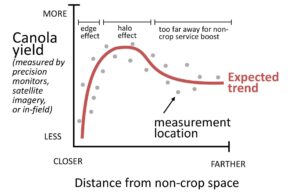Researchers measure the effect of non-crop spaces
KEY RESULT:
Keeping non-crop beneficial insect reservoirs – such as grass margins, treed areas, wetlands, and shelterbelts – near fields can help canola producers contribute to sustainability objectives while having a minimal (and possibly positive) impact on profitability and productivity.
PROJECT TITLE, PRINCIPAL INVESTIGATOR:
“Surveillance Networks for Beneficial Insects II: quantifying the canola yield effect of wetlands, shelterbelts and other insect reservoir habitats,” Paul Galpern, University of Calgary
FUNDING:
Alberta Canola, Manitoba Canola Growers
PUBLISHED ARTICLES:
Nguyen L et al.. 2022. “Medium-resolution multispectral satellite imagery in precision agriculture: mapping precision canola (Brassica napus L.) yield using Sentinel-2 time series.” Precision Agriculture 23:1051–71.
Nguyen LH et al.. 2022. “Effects of landscape complexity on crop productivity: an assessment from space.” Agriculture Ecosystems & Environment 328:107849.
Robinson S et al.. 2022. “Livin’ on the edge: precision yield data shows evidence of ecosystem services from field boundaries.” Agriculture Ecosystems & Environment 333:107956.
The second phase of the Beneficial Insects Surveillance Network (2019 to 2023) demonstrates that existing non-crop spaces near fields, such as field margins, treed areas, wetlands, and shelterbelts provide measurable benefits to canola producers in Western Canada.
Researchers collected and analyzed yield data from 1,075 field-years in central Alberta. This included field sampling in 20 unique canola fields, precision maps for 94 field-years of canola yield data (298 from all crops) and satellite images for 757 field-years of canola.
Study 1:
Can beneficial insects move into canola fields?
This study investigated whether natural enemies and the services they provide (i.e., pest regulation) were spilling over from non-crop spaces into canola fields. To test this, researchers placed pitfall traps and sentinel prey in canola fields at various distances from non-crop spaces. They found that natural enemies, the amount of egg predation, and caterpillar predation was higher nearer to non-crop spaces. There was no evidence that non-crop spaces were a source of spillover of important canola pest insects.
Study 2:
Can non-crop spaces improve canola yield?
The second study investigated whether non-crop spaces create a yield halo in the surrounding crop. Researchers measured canola yield near non-crop spaces to understand if, and by how much, these features were affecting canola production.
Yield maps from producer data, precision sources and satellite images showed a halo of higher yield, typically between 25m and 175m from non-crop spaces, in the average canola field. While this pattern represents an average trend across more than 1,000 fields, researchers note that it will be challenging to predict whether a producer will see a yield boost in a particular field or year. Also, large variation in the size yield haloes may be due to differences in types of non-crop spaces, management, and local environmental conditions. Researchers conclude that boosts to yield, if they exist, will be small, but they could be large enough to offset the drop in yield commonly seen among plants growing at field edges.
Finally, using a field experiment, conducted over three years, researchers showed that pollinators living in non-crop spaces are driving yield boosts observed 25m from wetlands.
In summary, results suggest that retaining existing non-crop spaces comes at little or no cost to production, and under some circumstances may benefit overall crop yield. Non-crop spaces can offer an insurance policy against pest outbreaks (e.g., as natural enemy reservoirs) or alternatively serve as biodiversity hotspots and carbon stores. Conserving habitat near fields could therefore help canola producers contribute to sustainability objectives in the agricultural sector and do so while minimizing impacts on profitability and productivity.
What Evidence of a Yield Halo Effect Would Look Like






